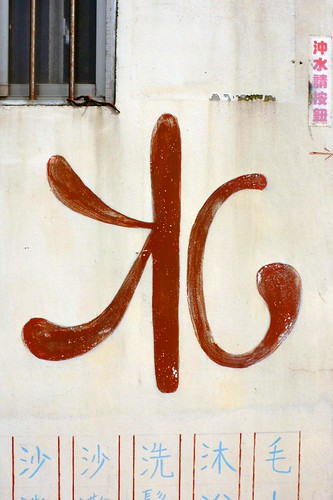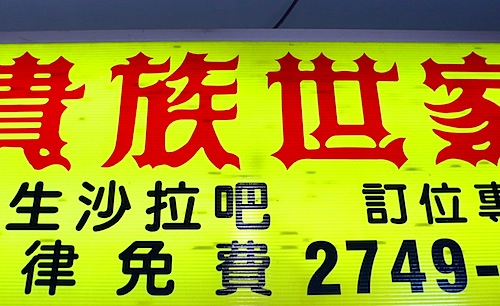Note: Because posts without photos are boring, and because I am a typography nerd, I will sprinkle this post with images of various Chinese characters we’ve found while in Taiwan.
As I mentioned in a previous post, we are not just in Taiwan to play, but also to study Chinese (me for reading, writing, and some intermediate grammar stuff; Jeremy for speaking). Prior to arriving in Taiwan, we researched several different language schools and settled on Taipei Language Institute (TLI), partially because they were the most professional (answered our emails right away, sent us materials about the program, etc.), and partially because we could do private lessons at an affordable price (we pay NT$380 or approx. US$11.50 per hour because we take 8 hours of lessons each per week; if you take 10 or more hours a week, it is even cheaper).
It turned out to be a great choice, as TLI is geared towards foreigners and has a unique approach to teaching Mandarin. As someone who grew up going to Chinese school every weekend, I know a thing or two about strict Chinese teachers…the traditional teaching method seems to revolve around rote memorization, making you feel guilty about not working hard enough, writing each Chinese character over and over until your hand has permanently cramped into a fist, followed by some more rote memorization. Writing, pronunciation, speaking, and listening are taught concurrently and given equal emphasis, which means that if you are starting out from ground zero (like Jeremy is), it can take you a REALLY long time before you start understanding any spoken conversation, because you spend so much time learning Chinese characters (which, as you can imagine, is, um, kinda hard!).

Beautifully hand-drawn character for “water.” Found in Fulong.
The TLI approach is pretty different. If you are a beginner, you learn the oral language first (listening and speaking), and after you’ve mastered some of the basics, then they teach you how to read/write. This is a pretty smart approach, and caters well to those who need a little instant gratification to stay motivated. ![]() We’ve been in class for about 6 weeks now, and Jeremy’s listening comprehension is already light years ahead of where he was when he studied with a more traditional teacher for 6+ months in the States. He picks a good percentage of the conversation when I speak to people around town, and even busts out a little Mandarin on his own from time to time! Cute story: there is a lady down the street from school who sells steamed pork buns. She is very encouraging of Jeremy…last time she made a huge commotion about how much his Mandarin has improved. Not only does she pump up his ego, but he gets a pork bun at the end of it too! Talk about classical conditioning!
We’ve been in class for about 6 weeks now, and Jeremy’s listening comprehension is already light years ahead of where he was when he studied with a more traditional teacher for 6+ months in the States. He picks a good percentage of the conversation when I speak to people around town, and even busts out a little Mandarin on his own from time to time! Cute story: there is a lady down the street from school who sells steamed pork buns. She is very encouraging of Jeremy…last time she made a huge commotion about how much his Mandarin has improved. Not only does she pump up his ego, but he gets a pork bun at the end of it too! Talk about classical conditioning!
Another interesting feature of the TLI experience revolves around the teachers. We have a different teacher for each hour of class. For me, this works out well, as I spend the first hour working on writing and reading, while the second hour is spent with a different textbook on grammatical patterns. Jeremy uses the same book both hours, so his first teacher just makes a note of where they ended and the second teacher picks up where they left off. At first we thought this switching teachers business would be confusing, but it turns out we really like it! It keeps the energy fresh and you get the benefit of two different people with two different skill sets enhancing your studies.

We go to school four days a week (Monday through Thursday), for two hours a day. It doesn’t sound like much, but we are exhausted afterwards! Since we are taking private lessons, the classes are fairly intense. Plus, we spend at least 2-4 hours outside of class studying and preparing for class, so most of our days are taken up with our Chinese lessons.
A while back, I described Jeremy learning Chinese as the equivalent of me trying to learn orthopedic surgery. I sort of wasn’t exaggerating…Chinese is really hard! What exactly makes it so difficult? Well, there are the obvious reasons:
- Lack of an alphabet
Pronunciation of Chinese characters cannot be deciphered from the character’s appearance. To make matters worse, often the same character can be read in two entirely different ways. Ever mindful of being efficient, Chinese people just started using the same character for two entirely different words instead of introducing new characters. Why unitask when you can multitask? Why just give a word one meaning…why not several? For example, the character 行 can be read as xing (meaning “all right”) or hang (meaning “professional”), depending on the context in which it is used. You’re just supposed to figure out how it is read based on the other words around it.Note that there are two different phonetic systems that indicate the pronunciation of a word (bo po mo fo and pinyin), but these systems are only used in textbooks for little kids…you rarely see them on signage or other printed matter out in the real world.
- Tones
Like many Asian languages, Chinese is tonal. There are 4 tones, which means that the sound ma spoken in the first tone (question word) has a completely different meaning than the sound ma spoken with a fourth tone (”to punish”). As you can imagine, it is important to get your tones right, or you can be easily misunderstood.Again, to complicate things, there are also tons of words that sound exactly the same (even the same tone) but have totally different written characters and therefore meanings. You derive their meaning based on the context in which they are spoken. Jeremy has been complaining a lot about the word jiu (with a fourth tone). It can mean: “ancient,” “at once,” “to rescue,” or “uncle.”
Those are the main reasons people point to when trying to explain why even basic Chinese is so hard to master. But even for someone whose first language was Mandarin, the more I study it, the more I realize how many idiosyncrasies there are in the language. I mean, I may not have a huge vocabulary, but I know how to put sentences together (Chinese grammar can be tricky), which is half the battle. Here are a few more weird little quirks in the Chinese language:
- So many numeral multipliers, so little time
For whatever reason, Chinese people can’t just say “a noodle,” or “the book.” There are dozens of words for the word “a” or “the.” Seriously. What they do is group things into categories and then apply something known as a numeral multiplier: all long skinny things get one type of word for “a” (tiao), all flat thin things get another word (zhang). I even learned recently that there are different numeral multipliers for the word “movie,” depending on if you want to emphasize that it is scheduled (bu), if you are going to see it in a multiplex theater (chang), or if you just want to go to a plain old movie (ge). It’s basically like saying, “Hey! Instead of saying ‘a pencil’ we’re going to start saying ‘b pencil’! And then everything that is long and skinny like a pencil, we’ll say ‘b’ too! As in, ‘I bought b really nice ribbon! I think b ribbon really brightens up a gift. And by the way, put b ribbon on c table.’” - If the glove doesn’t fit, you must omit
Even if you kill yourself remembering all the grammatical rules and linguistic constructs, you still might not understand someone when they’re talking to you. Why? Once again, Chinese efficiency rears it’s ugly head. Chinese people will omit any words that are not absolutely necessary in a sentence, while still getting their meaning across. It’s sort of hard to explain, since there isn’t really an English equivalent. But you’ll know you’re getting the hang of it when you can say a sentence with fewer words, not more (because it can be tricky to know exactly which words to omit). If someone asks you “Are you making dinner tonight?” and you say “Not make,” rather than “I am not making dinner tonight,” give yourself a pat on the back…you’re an advanced Chinese speaker now!
So yeah, we’ve sort of got our work cut out for us. I’m choosing to see this as an education that may take a lifetime, rather than something that I can master in 6 months or a year or 5 years or whatever. By the end of our time here, I will probably recognize close to 1000 characters. I was really proud of myself until my teacher told me today that little kids graduating from elementary school know at least 3000 characters. So let’s see, that makes me equivalent to, what, a third grader? Rock on!
I have to admit, though…I didn’t expect it, but along the way, I have rediscovered my love of linguistics and what the study of a language can teach us about a culture. Even better, the culture I’m learning more about is my own, my family’s, and one that our kids will be a part of too.
P.S. The Director of TLI asked me to mention that TLI is now offering the HSK exam (apparently some sort of test that proves your Chinese proficiency). I guess it was previously only offered in Hong Kong in Japan, but now you can take the test in Taiwan, too.
P.P.S. We’ve been using a great online Chinese dictionary at Yellow Bridge. You can look up a word by English, Chinese, or pinyin, and even handwriting recognition! It gives you all kinds of useful information like character etymology, stroke order (huh huh), and even a sound file so you know how to pronounce the word.
P.P.S.S. OK, I promise, last one…for you iPhone users out there, we found a great flashcard app called gFlashPro that we use to drill ourselves on new words while we’re taking the bus to school. You just upload an Excel file with the front of the cards in one column and the back of the cards in another. Nerd alert!


I have a good example for the “If the glove doesn’t fit, you must omit” in English that is actually based on Chinese. The phrase “Long time no see” is clearly not grammatically correct English, but is actually taken from the Chinese phrase “Hao jiu bu jian”. “Long time no see” should actually be something like “It has been a long time since we’ve seen each other” but of course, Chinese efficiency cuts that phrase down to four words to get the point across.
good one, eddo! i didn’t think of that…you know, my lao shi told me that that phrase comes over from taiwanese. the proper mandarin way to say it is “hen jiu mei jian.” kinda interesting…